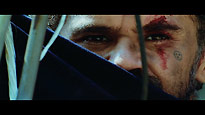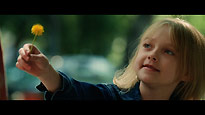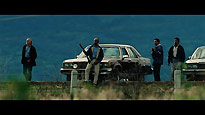|
MAN ON FIRE - TWO DISC COLLECTOR'S EDITION Region 2 (UK) Edition Director: Tony ScottFeaturing: Denzel Washington, Dakota Fanning, Marc Anthony, Radha MitchellCAUTION: This review contains minor spoilers!
"They're going to wish they'd never touched a hair on her head!" Rayburn THE FILM Man on Fire stars Denzel Washington as John Creasy, a washed-up, alcoholic former CIA operative, who finds work in Mexico as the personal bodyguard to the daughter of a struggling industrialist and his trophy wife, a precocious girl named Pita. Pita's non-judgemental friendship revitalises Creasy, but when she is kidnapped, he must face his own personal demons if he's to get her back alive. Tony Scott's blistering film, based on a book by A. J. Quinnell, simply crackles with energy. A heady mixture of films like Ransom (1996) and HBO's The Shield TV series, Man on Fire is a powerful thriller, jazzed up with some stylish visual tricks, and plenty of atmosphere, thanks to some terrific location work, in a city rarely seen on film. It's surely no coincidence that the trailers for Man on Fire used the theme music from The Shield. Washington is given fine support from True Romance's Christopher Walkern, in a supporting role as an old friend who finds Creasy a job; former salsa superstar Marc Anthony, as Creasy's troubled employer; and Pitch Black's Radha Mitchell, as the distraught mother. Ask anyone who's seen the film, though, and they'll tell you that the film is stolen by a wholly remarkable, assured performance from Dakota Fanning, as Pita. Eleven year-old Fanning, soon to be seen in Steven Spielberg's new adaptation of War of the Worlds, is completely captivating, and it's easy to believe that Creasy could find redemption through his paternal relationship with her.
THE DVD The DVD is presented in 2.35:1 anamorphic widescreen format (contrary to the company's press release, which said it would be in 1.85:1 ratio). The film is shot in a highly-stylised way, with a deliberately gritty, heavily-processed, high-contrast look that fits in very nicely with the film's NYPD Blue-style handheld shooting style. As such, it's a little difficult to judge whether or not the disc offers an accurate representation of the film that cinematographer Paul Cameron shot. It's a very satisfying transfer, however, with extremely deep blacks, heightened colours, and a suitably grainy appearance. If you've seen some of Cameron's other work (which includes Collateral, Swordfish and Gone In Sixty Seconds), you'll have a good idea of what to expect. The film was shot using the Super35 format, and then matted. The average bit-rate is 5.21Mb/s. Moving the bonus features from disc one onto disc two would probably have meant upgrading disc two from a DVD-5 to a DVD-9, so the relatively low average bit-rate is understandable, if not ideal. Frankly, the film is so kinetic that there's never time to dwell on any deficiency in the picture. The layer-change, (at 61'58") is remarkably well-placed, and not at all disruptive. There are two audio soundtrack options on the disc, offering a choice of Dolby Digital 5.1 (at 448kbps) or DTS 5.1 (at 754kbps) presentations. You can toggle the audio on the fly and, although the commentary track gets in the way, it's relatively easy to compare the two versions. The mix, which features a spiky score (predominantly by Harry Gregson-Williams, but three other composers are credited, and the film also uses source music and cues from other scores), is extremely dynamic, with plenty going on, and a lot of low-frequency bass activity. The film features extensive use of on-screen subtitles and captions. These can be quite elaborate (they move around the screen, sometimes weaving in front of and behind objects on the screen), so it's not surprising that they are presented as they appeared in the theatrical presentation. Trying to do something similar with player-generated captions would have been extremely difficult. The film and bonus materials are supported with optional English HoH subtitles. This extends to the commentary on the film and the commentary on the deleted scenes.
THE BONUS MATERIAL DISC ONE The disc kicks off with the usual tiresome array of trailers, legal warnings and adverts. For the record, these are: an anti-piracy warning, a FACT warning, a Dodgeball trailer, a Maltesers advert, a trailer for The Clearing, a Johnson Family Vacation trailer, a Taxi (remake) trailer, an Alien Vs Predator trailer and another Maltesers advert. Once you get past the FACT screen, the rest of the material can be skipped individually with the chapter forward button, or skipped entirely with the Menu button. There are two bonus features on Disc One: a commentary track, by Tony Scott, and the deleted scenes (with optional commentary by Scott). The film is quite a long one (140m), so it was wise to move as much as possible onto the second disc. Oddly enough Man On Fire has so far only released as a single-disc edition in the US. Their version features two commentary tracks: the one by Scott, and a second one, by producer Lucas Forster, screenwriter Brian Helgeland (director of similar revenge flick Payback, 1999) and co-star Dakota Fanning. This naturally prompts the question "why doesn't the UK disc feature the second commentary track?" Space may have been an issue. PAL formatting requires marginally more disc space than the equivalent amount of NTSC material. A simple 2.0 audio track takes up very little space, and it should have been possible to accommodate another one by dropping one or two trailers. It seems more likely that the track was omitted for another reason (perhaps Fox simply wanted the US disc to feature something exclusive?) Scott's commentary track is well-worth listening to. He doesn't come across as being meticulously-prepared, like his brother seems to be, but it's nevertheless very interesting. Man on Fire had a long gestation period. It was originally developed by Scott more than twenty years ago, between The Hunger and Top Gun, initially as a project for Marlon Brando, and then for Robert De Niro. In the end, Scott didn't make the film, which was eventually made in 1987, starring The Right Stuff's Scott Glenn in the Denzel Washington role. Scott touches on every aspect of the production. He talks, for example, about how moving the setting of the film from Italy to Mexico changed the film (in the Italian version the Mafia were involved in the kidnapping); and about how some of the techniques he used in the film were tried out in a short film he'd made for BMW. It's a commentary that doesn't pull its punches. Several times Scott points out occasions where the studio wanted changes made, in an attempt to broaden the film's appeal, or to avoid criticism. Deleted Scenes (31m) In his commentary Scott suggests that the deleted scenes can be viewed as a "stand-alone" accompaniment to the film, in as much as they tell their own story. There's certainly been some effort put into their presentation (in non-anamorphic widescreen format, with 2.0 stereo audio at 192kbps). Several of the scenes are unfinished, with holes on the audio track (especially noticeable where there would have been music). Each scene is presented with material either side which helps place it in the context of the finished film. The bitrate for the deleted scenes has been kept low, so they're slightly fuzzier than they could have been. The scenes add small touches of information (background about Creasy's family, for example, and about a hand injury), but Scott was wise to omit them. Interestingly, Scott notes that there was even more deleted material available (including a scene where Pita falls off a roof, and sprains her ankle), but he decided not to include it on the DVD because it was "too saccharine". One of the scenes was left out because the studio had concerns about the amount of violence in the film. Another, which shows the death of one of the supporting characters, was omitted because Scott decided to leave the audience to piece some of the story together for themselves. The Alternate End is especially interesting, as are Scott's reasons for not using it. The deleted scenes are (SPOILERS!): Lisa asks for a bodyguard; Lisa and Samuel have sex; Lisa talks to Creasy / Creasy meets Jordan Kalfus; Pita prays for a dog; Pita asks Creasy about his family; Pita asks Creasy about his hand; Creasy saves Lisa at assassination / Sex with Lisa / Aftermath; Lisa tells Samuel that Creasy has to go; Samuel plays piano / Creasy talks to Manzano / Lisa prays; Pita's ghost appears in backyard; Creasy kills kidnapper Sandri; Jordan Kalfus explains the kidnapping of Pita; Samuel kills Jordan; Creasy talks to Marianna and Manzano; Alternate End. DISC TWO Vengeance is Mine - Reinventing Man on Fire This well-structured, seventy-three minute documentary, produced by Charles de Lauzirika for Lauzirika Motion Picture Company, is an insightful look at the production of the film. It focuses on five particular aspects of the film-making process, as indicated in the titles of the five chapters: Twenty Year Odyssey - Project Development, The Business of Kidnapping - Technical Advisors, Caught in the Crossfire - Casting and Characterization, City of God - On Location: Mexico, and Fire and Passion - Visual and Emotional Style. It also provides some background to the subject matter of the film. It includes interviews with all the featured cast members, and key members of the production team, including Scott, and cinematographer Paul Cameron. The only notable absentee is composer Harry Gregson-Williams, but this may because the spotlight is firmly on the pre-production and production phases of the project. The interviews show no signs of being standard EPK-style fluff, and were probably shot specifically for use here. Interviewees include the technical advisor who Scott was wary of identifying by name on the commentary track, former DEA agent Donald Ferrarone. The documentary is substantial, and concise. It features a good variety of source material, giving it texture, and it's edited together very efficiently. Points the interviewees make, particularly those about their relationship with the director, are reinforced with well-chosen behind-the-scenes footage. Whilst not quite in the same league as Lost in La Mancha or Hearts of Darkness (the documentary about Apocalypse Now), this is a fine piece of work. Pita's Abduction There are two options here. The first is to view Tony Scott's forty-odd thumbnail-size, cartoonish storyboards for this pivotal sequence. The second is much more elaborate, offering options to view the film material from four different cameras (one of which is usually the hand-cranked "cross-process" camera), or a Four Angle Composite. It's probably best to watch the composite version first, for an idea of what each shot is. The composite view is captioned with the type of lens being used, and the number of frames per second it's shooting at. This sequence, which runs for about four minutes is offered with a choice of production audio, or commentary by Tony Scott. The presentation is very similar to the Fish Market Shoot Out presentation on the Hannibal DVD. The footage from each camera is presented in 1.78:1 anamorphic widescreen format. Music Video - Oye Como Va by Kinky (3m) A generally unremarkable music video with a Latin flavour. The band's performance is inter-cut with clips from the film. presented in non-anamorphic widescreen format, with Dolby Digital 2.0 audio (at 192kbps). Photo Gallery A standard button-push driven gallery of about sixty photo's, including a couple of pictures of Bill Clinton visiting the set. Trailers Three theatrical trailers (A, B and C, total: 7m), and four TV spots (Meeting, Time, Fire and Masterpiece, total: 2m). There's an option to play each group, but not one to play everything.
SUMMARY Scott's well-structured, visually-exciting thriller is likely to find a very appreciative audience in its home video incarnation. Twentieth Century Fox Home Entertainment's UK DVD looks and sounds great, and has a terrific array of bonus materials, including an excellent seventy-five minute documentary. The two-disc UK version effortlessly betters the only available US edition, although their disc features a commentary track that's not been included on the UK edition. Fox's UK division apparently has a free hand to release anything they want, and are grasping this opportunity with a series of excellent two-disc editions (other recent examples include The Day After Tomorrow and The League of Extraordinary Gentlemen). 2010 UPDATE The UK Blu-ray edition maintains the distinction of featuring bonus materials that aren't on the US Blu-ray edition. Even better, the UK Blu-ray includes the second commentary track, which wasn't featured on the UK DVD. It's an excellent Blu-ray release from Fox UK, especially considering that many of their Blu-ray catalogue titles have dropped many or all of the bonus features from the equivalent DVD version. |
|||||||||||||||||||














